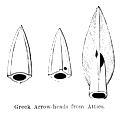Sagitta
(
ὀϊστός, ἰός, τόξευμα). An arrow. Ancient arrows like
those of modern times were feathered and tipped with metal (
Scut. Her.
130-134). The point was called
ἄρδις (
Herod.i. 215). Flint arrow-heads have been found in Italy; and the Aethiopians in the
army of Xerxes used
 |
|
Greek Arrow-heads from Attica.
|
arrows tipped with a sharp stone (
Herod.vii. 69); but
Greek arrows were generally pointed with bronze, and this as early as Homer, who uses the
epithet
χαλκήρης of one (
Il. xiii. 650 Il., 662). The Homeric
arrow-head, however, was three-tongued, and had barbs (
ὄγκοι,
Il. lv. 151). The Romans called barbed arrows
hamatae and
aduncae; and did not poison the ends (
venenatae sagittae), as did the Getae, Scythae, and Mauri. Arrows were used
 |
|
Ivory Arrow-head. (Schliemann.)
|
in warfare to carry fire. By this means Xerxes set the Athenian acropolis on fire
(
Herod.viii. 52), and Caesar used fire-arrows to set fire to
Antony's ships (Pollux, i. 37). Archers were called
sagittarii by the
Romans, but in earlier times
arquites. See
Arcus.






